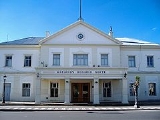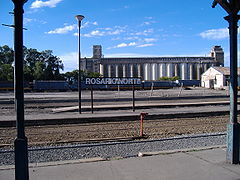
Rosario Norte Station
Encyclopedia


Train station
A train station, also called a railroad station or railway station and often shortened to just station,"Station" is commonly understood to mean "train station" unless otherwise qualified. This is evident from dictionary entries e.g...
in Rosario
Rosario
Rosario is the largest city in the province of Santa Fe, Argentina. It is located northwest of Buenos Aires, on the western shore of the Paraná River and has 1,159,004 residents as of the ....
, province
Provinces of Argentina
Argentina is subdivided into twenty-three provinces and one autonomous city...
of Santa Fe
Santa Fe Province
The Invincible Province of Santa Fe, in Spanish Provincia Invencible de Santa Fe , is a province of Argentina, located in the center-east of the country. Neighboring provinces are from the north clockwise Chaco , Corrientes, Entre Ríos, Buenos Aires, Córdoba, and Santiago del Estero...
, Argentina
Argentina
Argentina , officially the Argentine Republic , is the second largest country in South America by land area, after Brazil. It is constituted as a federation of 23 provinces and an autonomous city, Buenos Aires...
. It is located on Aristóbulo del Valle Avenue, at the junction with Callao St., north of the city center, in the neighbourhood known as Barrio Pichincha
Barrio Pichincha
Pichincha is a barrio in the city of Rosario, . It is located on the north-east part of the central area of the city, and its limits are Ovidio Lagos Avenue , Francia Avenue , Rivadavia Avenue, and Salta St.The assembling of this barrio was motivated by the growth of the railway lines and the...
.
The station was a terminus of the Ferrocarril Buenos Aires y Rosario company. The railway line was opened in 1885 and was the first to join Rosario and Buenos Aires
Buenos Aires
Buenos Aires is the capital and largest city of Argentina, and the second-largest metropolitan area in South America, after São Paulo. It is located on the western shore of the estuary of the Río de la Plata, on the southeastern coast of the South American continent...
(about 300 km south-southeast). From Rosario Norte the line continued to the northwest, crossing several provinces of Argentina to reach Tucumán. In 1908, after the merging of the Ferrocarril Buenos Aires y Rosario and the Ferrocarril Central Argentino companies, the station was set aside to handle long-distance and express services. Around 1935–1940, a few years after the "golden age" of the Argentine railway system, Rosario Norte served 326,000 passengers per year (more than 800 daily).
In 1977 almost all of the local and mid-distance passenger services were cancelled. Rosario Norte was left in charge of the few remaining ones. Starting in 1991, passenger train services were eliminated throughout the country, while cargo lines were privatized
Privatization
Privatization is the incidence or process of transferring ownership of a business, enterprise, agency or public service from the public sector to the private sector or to private non-profit organizations...
. The Rosario Norte—Retiro
Estación Retiro
Retiro Station is a large railway terminus in the Buenos Aires central business district in Argentina, located in the district of Retiro, opposite Plaza San Martín, a large public square....
(Buenos Aires) line was shut down in July 1992, and the services going from Rosario Norte to Tucumán suffered the same fate in March 1993.
Rosario Norte was reactivated in October 1997, as the exploitation of a new passenger service between Tucumán and Buenos Aires was granted by the government of Tucumán to the firm Tucumán Ferrocarriles
Tucumán Ferrocarriles
Tucumán Ferrocarriles S.A. is a company in Argentina which operates a railway line between Buenos Aires and Tucumán in Argentina built by the state-owned Ferrocarril Central Norte, which became part of Ferrocarril General Manuel Belgrano after railway nationisation in 1948.As part of a national...
. At the same time, the municipality of Rosario
Government of Rosario
This article is about the government of Rosario, the third most populated city in Argentina, and the largest in the province of Santa Fe. Rosario has about 910,000 inhabitants and is located on the western shore of the Paraná River....
took over most of the building and began to reform it for administrative use. In June 1999 the Municipal Secretariat of Culture and Education was installed there, sharing the facilities with Tucumán Ferrocarriles and with a cargo train company (Buenos Aires al Pacífico/América Latina Logística).
After the turn of the millennium, restoration and maintenance of the station's infrastructure, overdue by about two decades continued, and new services were added. , Rosario Norte manages two passenger services from Buenos Aires, a weekly one run by Trenes de Buenos Aires
Trenes de Buenos Aires
Trenes de Buenos Aires is a privately-owned company which, on 27 May 1995, took over the concession, granted by the Argentine government as part of railway privatisation during the presidency of Carlos Menem, for the operation of commuter rail services in Buenos Aires, Argentina over the broad...
(TBA), and another one (four days a week) run by Ferrocentral
Ferrocentral
Ferrocentral is a private railway company in Argentina, its name being a combination of the Spanish words for "Central Rail." It operates long-distance passenger trains from its base at Retiro Station in Buenos Aires to several locations in northern Argentina...
. The latter company also has a weekly service to Tucumán and one to Córdoba
Córdoba, Argentina
Córdoba is a city located near the geographical center of Argentina, in the foothills of the Sierras Chicas on the Suquía River, about northwest of Buenos Aires. It is the capital of Córdoba Province. Córdoba is the second-largest city in Argentina after the federal capital Buenos Aires, with...
. These services are considerably slower than going by bus, but also safer and much cheaper.

